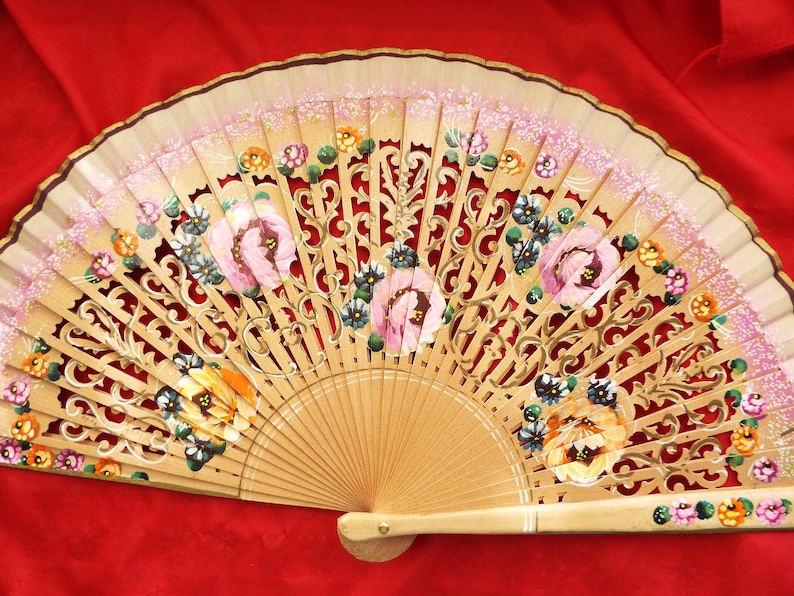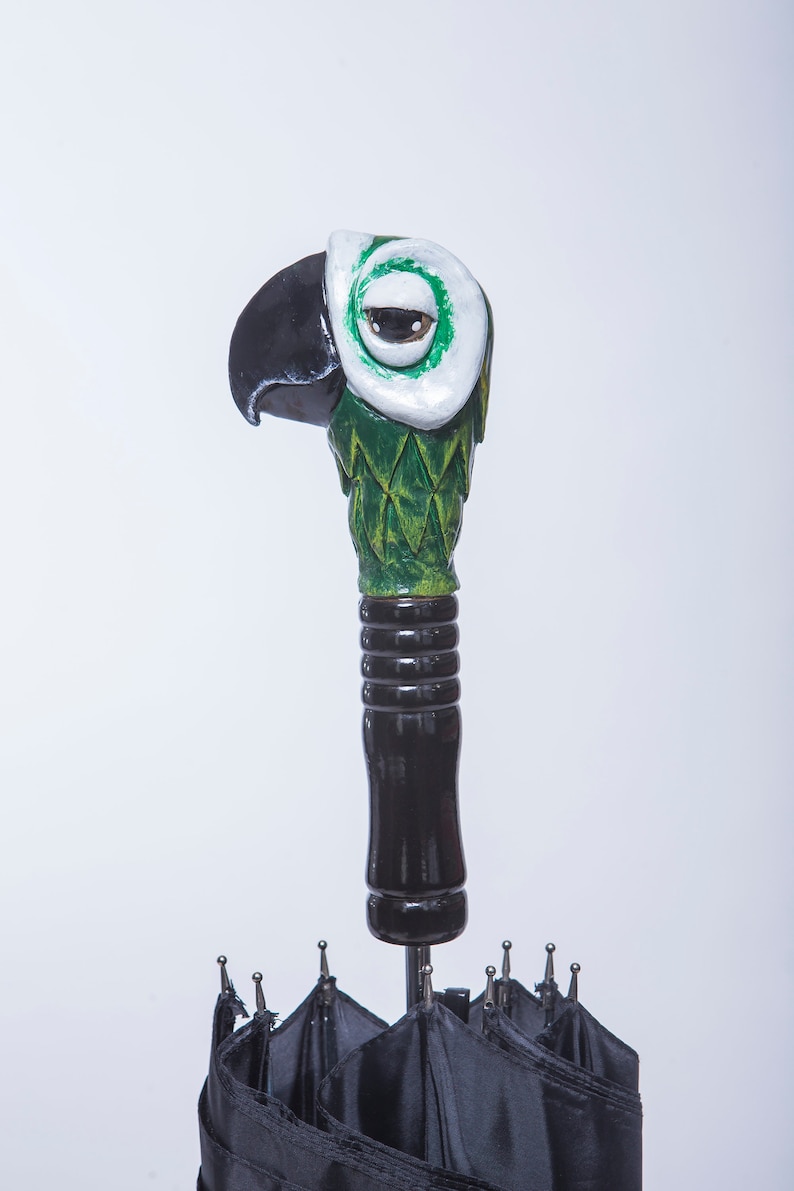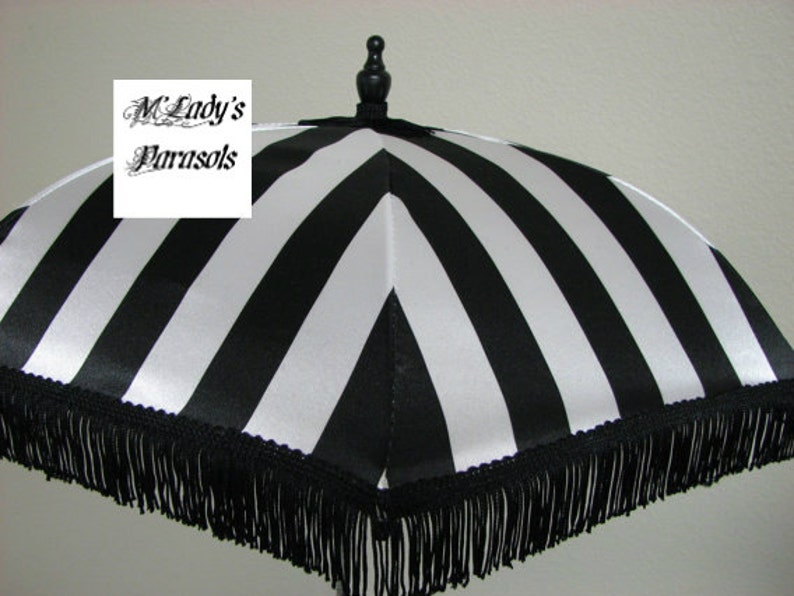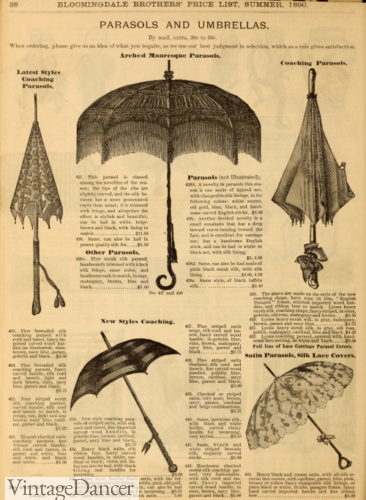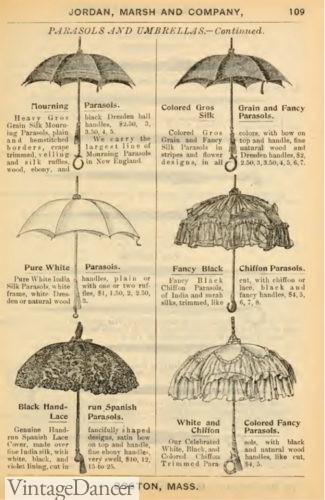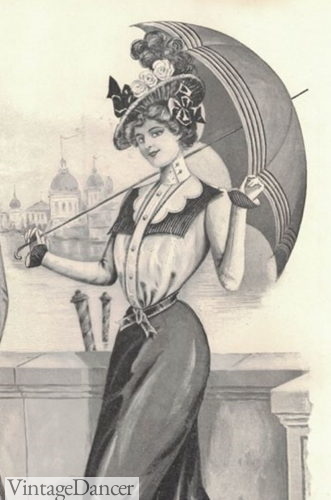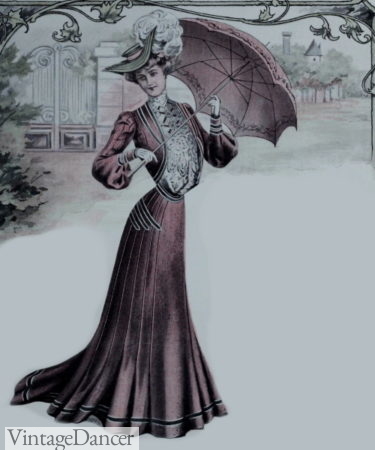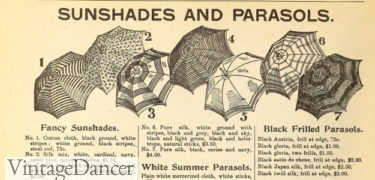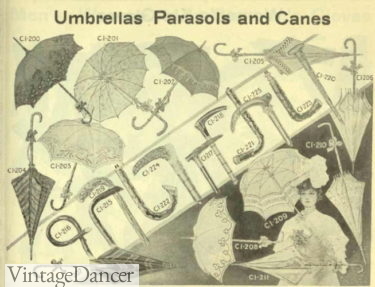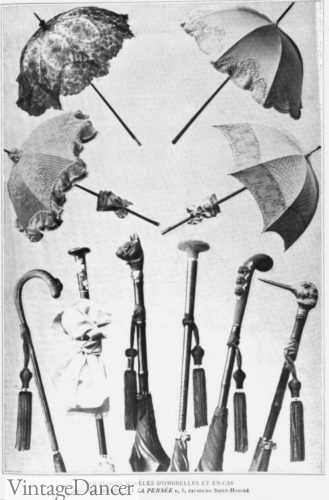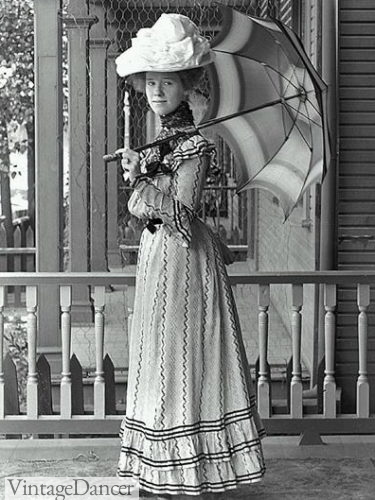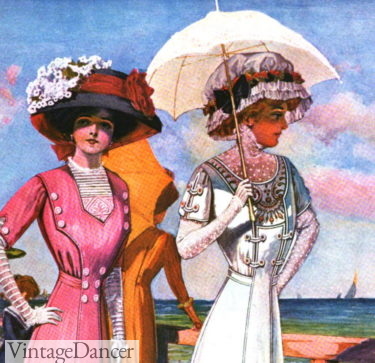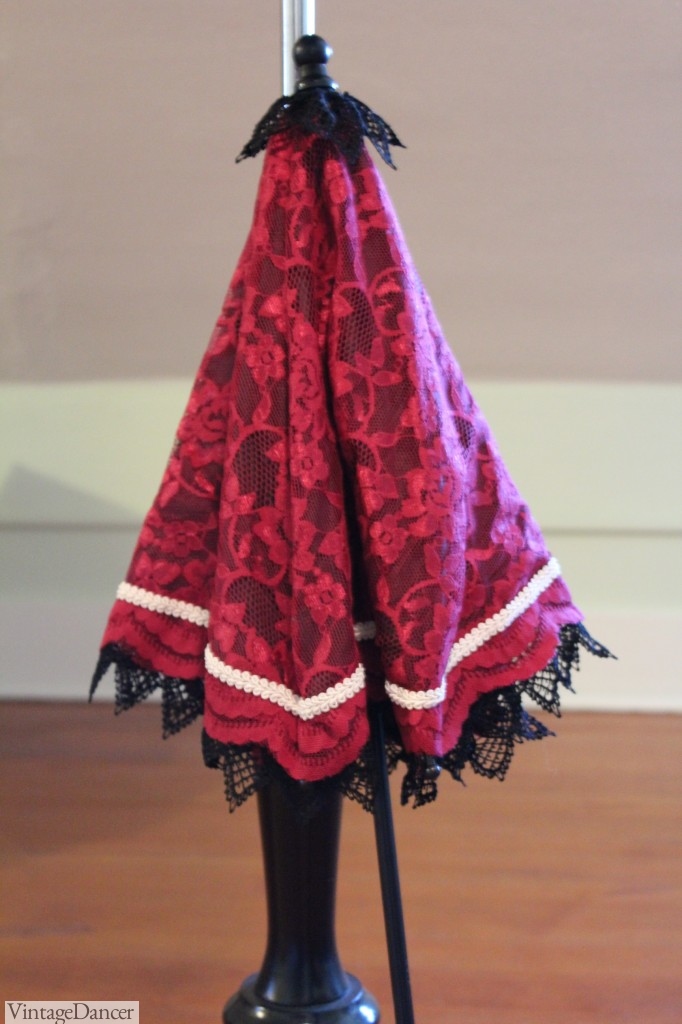
My Carriage Parasol
I have wanted a Victorian Parasol to wear with my Victorian and Civil War costumes for a long time. Ready made lace parasols can be quite expensive. Cheaper “costume” quality parasols are OK, but often have very short handles, making them uncomfortable to hold up for any length of time. The Carriage parasol has a long handle and smaller width than traditional parasols. They are a perfect blend of size, length and fashion:
“Parasols for carriage rides were generally smaller than those for walking. Some models even came complete with a flask in the handle for the benefit of travelers. Towards the end of the 19th century, covers of chiffon and fancy silk on very long sticks became the fashion. Ladies carried their umbrellas closed more than open, and gentleman carried theirs tightly furled to resemble a walking stick. ” www.literary-liaisons.com
Since I couldn’t find a ready made carriage parasol to buy, I set out to make one.

A cheap parasol with a long handle is what I used for the frame.
Step 1: I started with a nylon “costume” parasol that was the correct length and size. Most parasols have short handles. One friend said she just replaced the handle with a wood dowel from the craft store. A genius idea! Fortunately, the one I bought had a long enough handle.
These are not very sturdy for vigorous use. Since I only plan on using it two or so times a year as an accessory, durability doesn’t matter. And since I was going to cover it with nice lace and trim, the Nylon cover wasn’t important either. What is nice about this Parasol is the wood handle. I would have drawn the line at plastic, but at least the wood handle is more authentic.
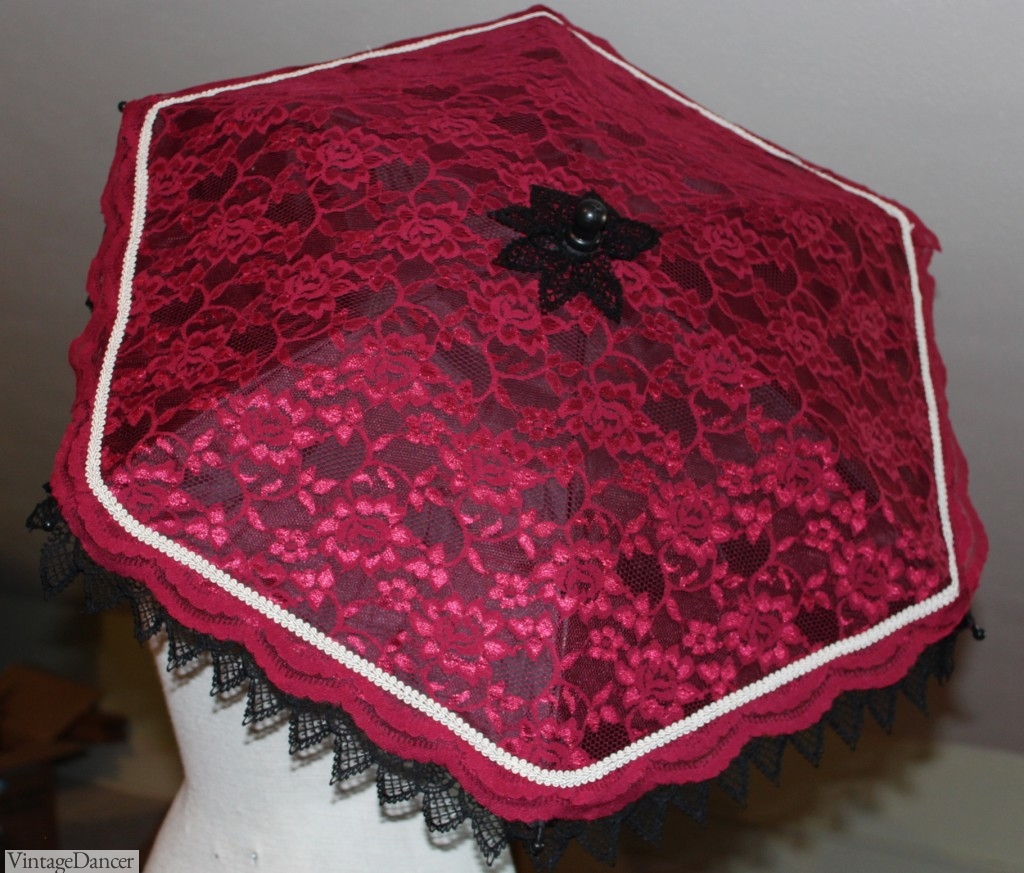 Step 2: I started with a black parasol and planned to cover it with black lace. However, since my Victorian dress is Maroon I opted for a Maroon lace with black lace trim and an ivory rope trim accent. I think the combination laid over the black nylon looked great. I found all the material and trim at my local Hancock Fabrics store. The cost was about $18.
Step 2: I started with a black parasol and planned to cover it with black lace. However, since my Victorian dress is Maroon I opted for a Maroon lace with black lace trim and an ivory rope trim accent. I think the combination laid over the black nylon looked great. I found all the material and trim at my local Hancock Fabrics store. The cost was about $18.
You will need 1 yard of lace (or any material you like with a bit of stretch/drape to it) and 2 yards of trim to go around the entire edge of the parasol. Add 6 inches more if you want an accent on the top.
Step 3: Start with the lace trim that will go all around the edge of the parasol. Hand sew the lace with a whip stitch so that it hangs down nicely from the edge off the Nylon.
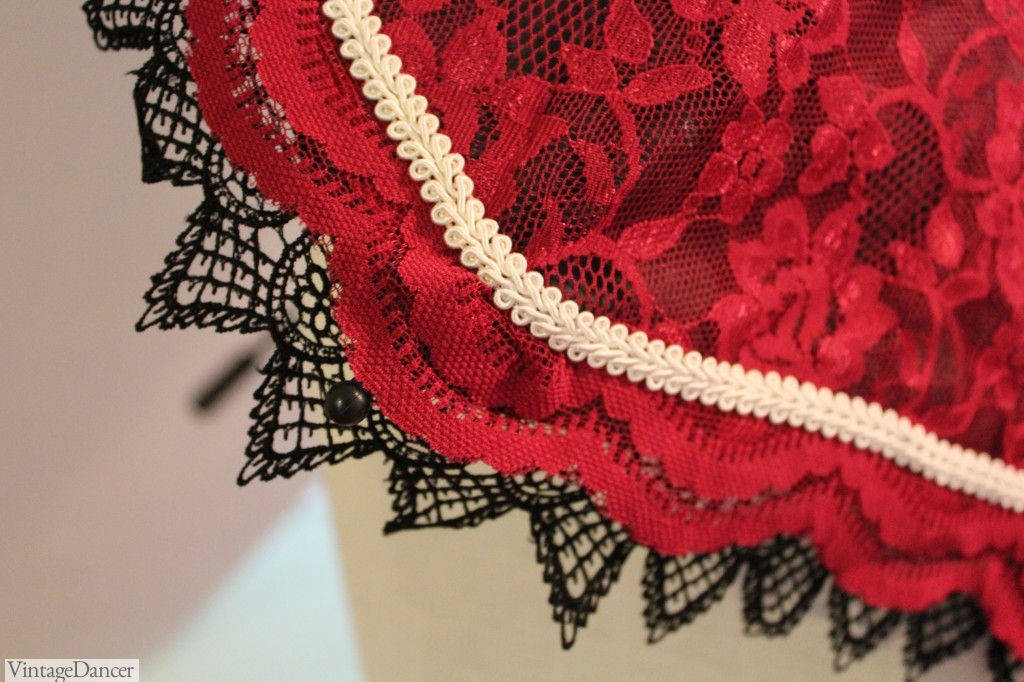
Step 4: The correct way to recover a parasol would be to cut triangles of fabric and sew them together just like how it’s made with the original Nylon. However that required more time than I had – remember, I have a baby in the house now 🙂 . The “cheating” method is to lay the yard of lace over the entire parasol, cut a small hole at the top to fit over the tip, and pin the fabric to the Nylon. The fabric will hang over the edges at various lengths. Simply cut the extra lace off all around parasol edge. If you have too much fabric on top to make a snug drape you can fold the extra under and along one of the wire frames then sew along top. I had to do this and it didn’t look bad. (Sorry I didn’t take pictures of the process.)
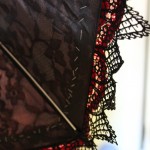
Sewn to the inside of a parasol
The lace I chose had a pretty finished edge to it so I cut that off and pinned it on over the lace overlay with a band of ivory trim to cover the cut edge of the lace trim. I pinned it all in place and then hand stitched it to the Nylon. The one thing that was odd about this is that I used ivory thread to stitch everything in place. On the underside of the Parasol, you can see my ivory thread against the black Nylon. Next time I think I’ll use black thread and keep my stitches hidden in the ivory trim.
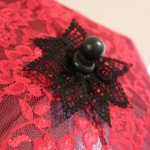
A big of lace around the top knob
Step 5: Take a bit of lace trim and run a gathering stitch along the edge. Pull the gathers in so it makes a circle and place around the Parasol tip. Stitch the trim in place.
Step 6: Enjoy! You now have a nicely decorated Carriage Parasol. The whole process took me just a few hours and turned out great. I would make this Parasol again in a heartbeat. My husband suggested I could make these and resell them. A great idea, but I think I’d rather just teach you how to design your own.
Happy decorating.
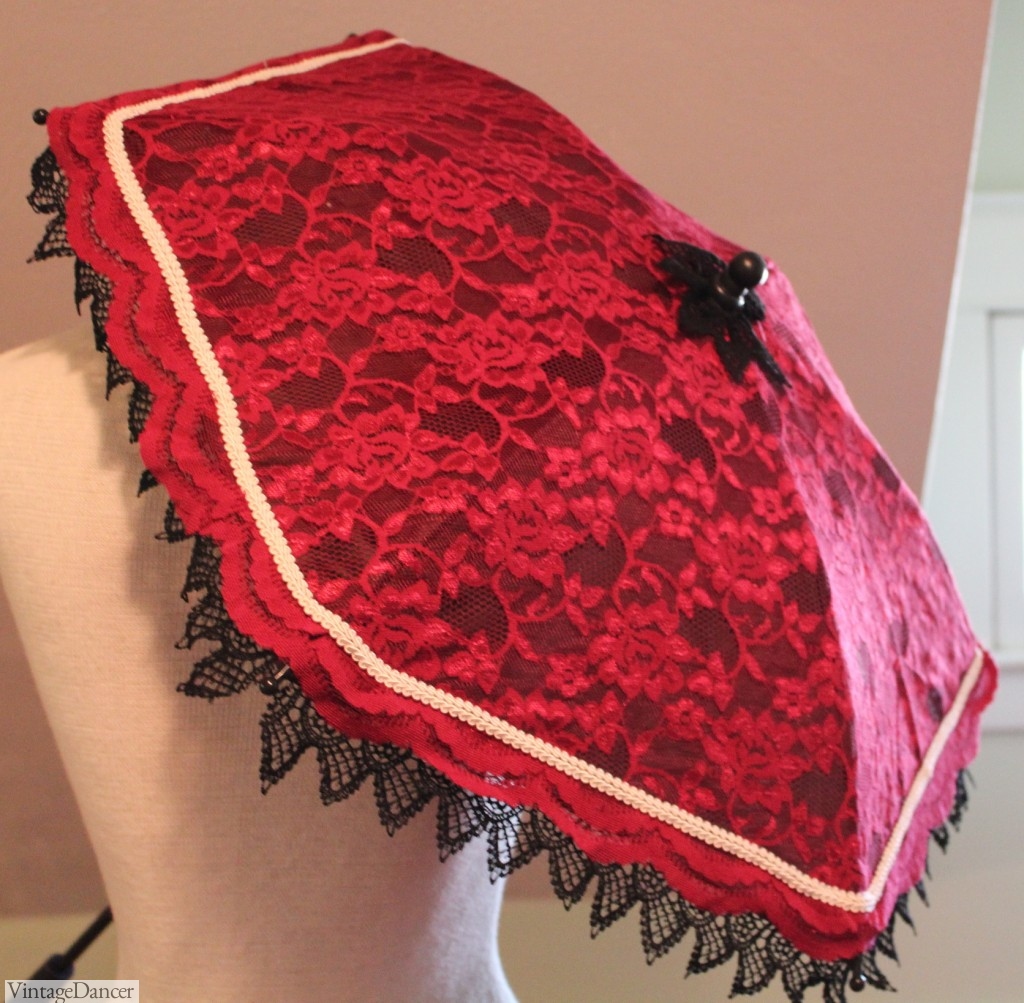
Complete!
Ready Made Victorian Parasols
For the less crafty or for sources of cheap costume parasols, look here:
History of the Victorian Parasol
From Victorian costume and costume accessories / by Anne Buck . Copyright expired.
Parasols to protect the face from the sun are a dress accessory now almost extinct, for today women turn their bare heads and faces to the sun like worshippers. When Queen Victoria came to the throne, the face was encircled by the brim of the bonnet, veiled at will with a bonnet veil and, as a third line of defense, shaded beneath a parasol.
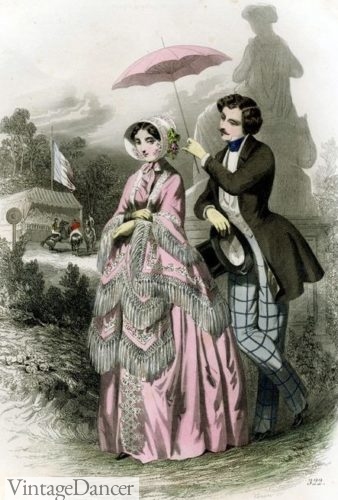
1840s small parasol
The parasols of the reign fall into three groups. The small parasols, with slender and usually folding sticks, are of the early Victorian period, from the beginning of the reign until about 1865.
After 1865, parasols take on a heavier look with thicker handles and more solid ferrules, and they increase in size and sturdiness in the late 1870s and 1880s.
Then in the last decade of the reign and century the parasol blossoms again with new, larger elegance. Large and long-handled, it develops after 1896 a new characteristic, a rich elaboration of the lining.
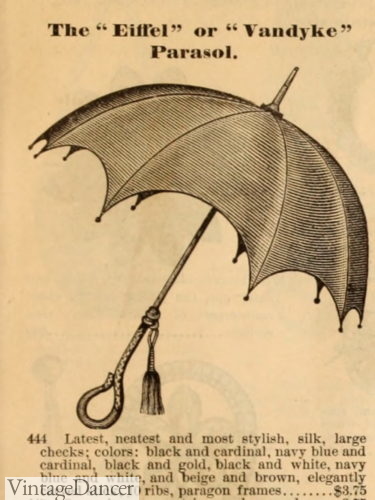
1890 parasols with large handle
The fashion for small parasols opens almost exactly with the reign. The fashionable parasols of its first summer were “Victoria parasols for open carriages”. They were “perfectly calculated for that purpose of a very small size and with folding sticks so that
they may be used to shade the face as a fan, they are composed of poult de soie chinée. Some are trimmed with fringes, others have
an embroidered border—all are pretty.
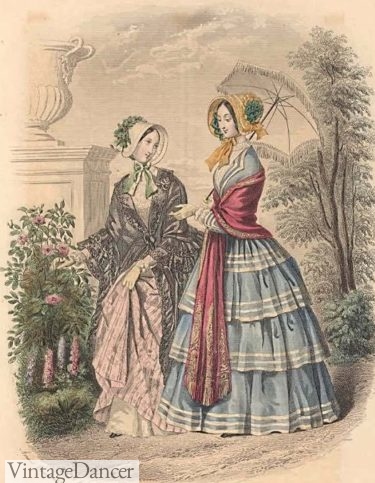
1846 parasol
As to the sticks, they are of wrought ivory and of antique patterns” (World of Fashion, 1838). This gives the general style of parasol for the first period. It stands in sharp contrast with the parasols of the 1820s and the early 1830s, which were larger and heavier, and had covers almost always of a single colour, usually green or brown, in plain twilled silk. In the late 1830s, handles and ferrules became slimmer and the parasol itself smaller. The difference between the parasols of the 1840s and the parasols which were used earlier in the century is thus clearly marked.
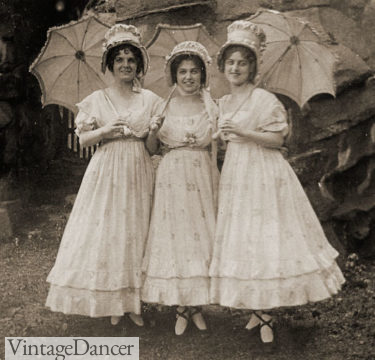
1840s girls parasols
There was no general change of style again until the 1860s, although there was much variety of detail. Within this first period of the reign the parasols show variety not only according to their date, but also according to their use and quality. Up to this time the parasol had not been a part of dress on which great expenditure had been lavished, and the utilitarian element was predominant in even the most elegant of the early nineteenth-century examples; but the carriage parasol of the 1840s was an object of elegant display.
The walking parasols were plainer, sometimes without a fringe, and they had a long stick ferrule instead of the small knob or ring of the carriage parasol. A pointed ferrule of carved ivory, a small version of the ferrule of the 1820s, is a link with the earlier parasols and is a sign of a date at the opening of the period.
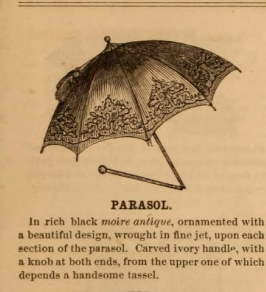
1862 folding parasol
The most elegant carriage parasols have handles of ivory, coral or mother-of-pearl, worked in elaborate designs, beautifully cut.
These elaborate handles are particularly characteristic of the 1840s, but they are found only in the more expensive parasols, and many handles of the simpler, but still gay and attractive parasols are plainly turned in ivory or wood.
The stick to which the handle was attached was usually of wood, but some parasols have sticks, as well as handles, of ivory. By 1850, frames with metal stick and ferrule were being made, although this was not exactly new, for a metal stick is often found on the parasols of the early nineteenth century.
In parasols of the best quality the ribs were still made of whale-bone during the 1840s; cane is found in the less expensive ones.
Metal ribs of tubular steel were patented by Hollands of Birmingham in 1840 and re-designed by them in 1850. Fox’s made solid steel ribs—mainly for umbrellas-in 1848, and patented U-section steel ribs in 1852. In 1851, metal frames were still more expensive than cane ones, so that the presence of cane ribs is as likely to be a sign of a less expensive parasol as a sign of early date. Whalebone ribs are rarely found after 1870.
The covers of the parasols were in all shades of silk. In 1849 there were: “all colors from plain green and brown to the most strong shades of pink, blue, etc.; some are of plain, others of figured silk, or figured only at the border. The more ornamental parasols suited to the carriage drive are trimmed with deep fringe or covered with guipure.
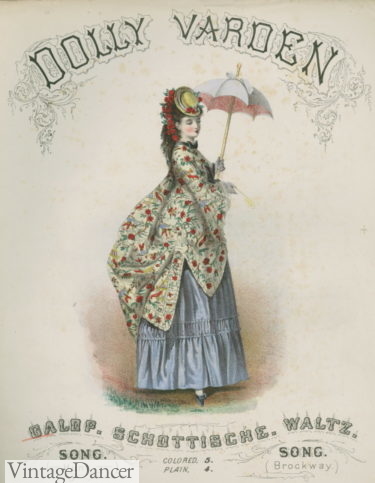
1872 parasol
For walking, plain parasols of rather larger size are preferred, but for the carriage those of somewhat smaller dimensions are found most convenient. The Marquise parasol, furnished with a hinge for turning the top on one side and with a folding stick, is peculiarly convenient for the carriage”. (Lady’s Newspaper, 1849). Some were covered in fabric which was specially woven or printed for parasol covers.
The parasols were often lined, usually with white silk, although a lining was less general at the beginning of the period.
Parasols of plain silk covered with black or white lace were a fashion of the 1850s and early 1860s.
“For occasions when a full-dress parasol is required nothing is so suitable and distinguished as black or white lace made up over a brightcoloured or white parasol” (Englishwoman’s Domestic Magazine, 1862).
During the 1840s and 1850s, a deep fringe was usual as an awning this disappeared in the 186os. Parasols of checkered silk, with a band of the darkest shade in the check as a border, were “amongst the novelties of the season” in 1862. There are also examples of feather-covered or feather-trimmed parasols from this period. There were two main shapes: the dome-shape usually found in the carriage parasol; and the shape in which the ribs weres lightly flattened before tapering into the ferrule. This was usually called a Chinese top, or a pagoda shape, and was usually a style for plainer parasols. This shape was particularly popular between 1860 and 1865, but is not limited to that period.
Square parasols, also, are occasionally found. During these years when parasols were much used, there were several devices to make their manipulation easier. Sangsters in 1844 patented the “Sylphide” parasol, which had a spring at the end of the handle so that the parasol could be closed with the hand which was holding it.
The folding stick which is found on most of the parasols of this period had its origin earlier. The sticks are hinged and the joint held by a short ivory or metal tube which slides over it. A second hinge to make the parasol tilt back at the top of the stick, found on some of the parasols of the mid-nineteenth century, was also an inheritance from the earlier nineteenth century. The folding stick disappears in the 1860s, but the tilting top is occasionally found in parasols of the next period.
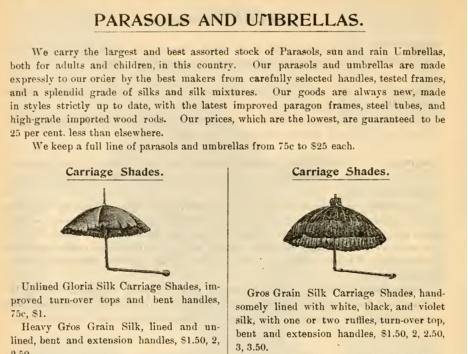
1897 folding Carriage shades parasols
The parasols of the next generation lose the elegance and delicacy of the early Victorian examples. Already in 1861 “parasols are generally worn of a plain shape without any trimming and are rather large … to serve us as an umbrella as
well as a parasol” (Englishwoman’s Domestic Magazine, 1861). The new parasols in the shops in 1865 were described as “umbrella shaped, rather large … a novelty in handles is their thickness” (Queen, 1865).
By 1866 the change is complete. “The sticks are much shorter than formerly and the handles extremely thick”
(Queen, 1866). The handles continue short and thick during the 1870s but become longer, though still rather heavy, in the 1880s. Heads of
animals and birds often decorate them in the 1870s and, in the 1880s, there are round-knobbed handles and natural knobbed ends of gnarled sticks of malacca briar, ash or vine.
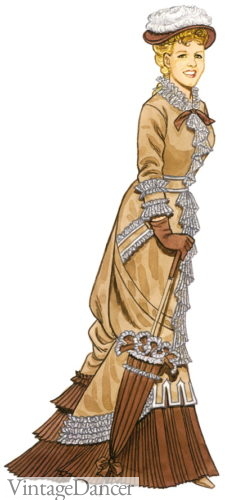
1887 walking parasols with matching dress
Large bows of ribbon decorate the handles in the 1870s and 1880s. The ferrules, like the handles, are slightly heavier in the 1860s, and then have a more definite change in the 1870s and 1880s. In the 1860s and early 1870s there are three types, a knob, a ring, and a stick; but in the late 1870s, the stick ferrule is general, and some parasols of this time have particularly long ones.
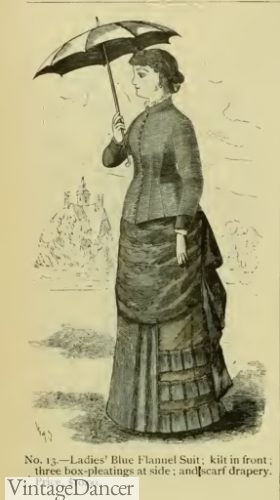
1883 parasol
Covers with ruched trimmings are a mark of the 1870s. A deep lace awning is also an ornament of the 1870s and 1880s.
Plain sunshades of silk with a border of contrasting colour are found at the same time as the more elaborate examples:
“the en-tout-cas which is enjoying such wide popularity just now was never seen in so large a variety of designs both as regards the colouring, material and handles. … In the parasol proper there is a great variety of new shapes. The double triangle, treble
triangle, pentagon and double pentagon, hexagons and octagons surmounted by their duplicate are all as novel as the new ideas
embodied in their covers” (Lady’s World, 1887).
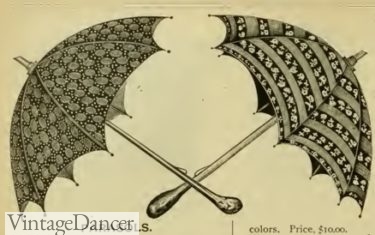
1882 parasols
In the late 1880s, parasols grow longer and appear slimmer when closed. The plainer parasols of the 18gos differ from those
of the 1880s in their longer, lighter sticks and larger covers, which lie closely to the sticks when they are closed.
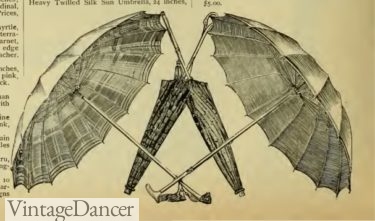
1882 parasols
The length of the sticks is usually between 36 and 40 inches, and the diameter of the cover between 24 and 35 inches. The corresponding sizes for the middle period of 1865 to 1885 have a length of 25 to 30 inches and a diameter of 20 to 25 inches; and, for the earlier period of 1835 to 1865, a length of 22 to 28 inches and a diameter of 16 to 22 inches.
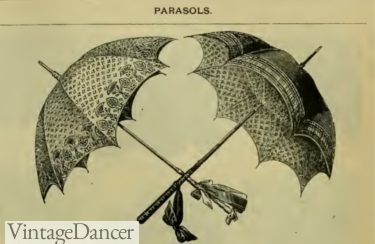
1883 parasols
The silks are once more lighter and brighter, and warp-printed designs are again fashionable. But the parasols of this period are to those of the 1840s as the peony to the pink. In 1896 attention is given to the lining, and for the next few years “Geisha” parasols with plain covers, but with linings of ruched and puffed chiffon or silk muslin are a characteristic fashion.
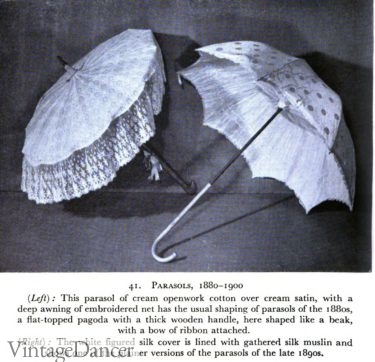
1880-1900 parasols
The handles are a small knob on an extension of the stick. Decorative china handles are very popular at this time. The plainer sunshades for morning wear are contemporary with more elaborate examples, and both pass together into the next reign.
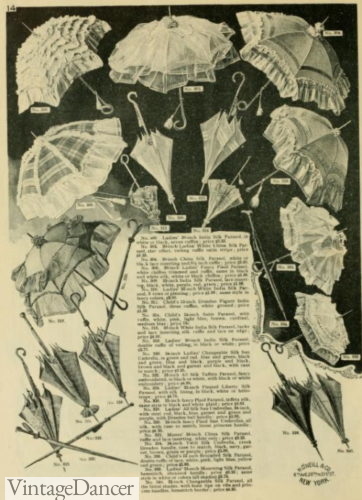
1898 parasols
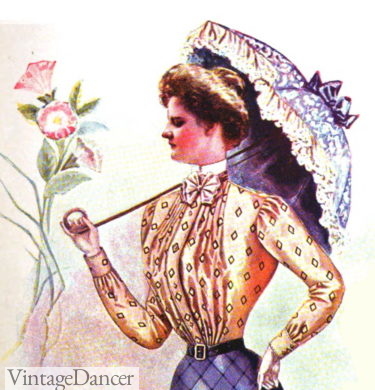
1899 lace trim parasols
- 1890 parasol
- 1897 parasol
Edwardian Parasols
History coming soon…
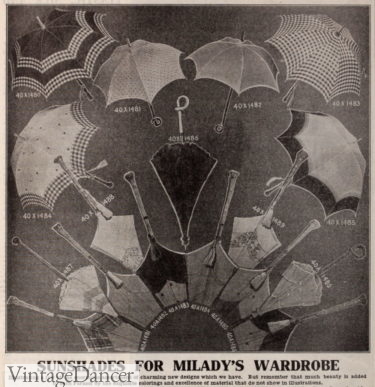
1908 parasols
- 1900 big parasol
- 1903 walking parasol
- 1904 sun shades and parasols
- 1906 umbrellas, parasols, and canes
- 1908 Parasols
- 1900s zig zag pattern
- 1909 parasol
Debbie Sessions has been teaching fashion history and helping people dress for vintage themed events since 2009. She has turned a hobby into VintageDancer.com with hundreds of well researched articles and hand picked links to vintage inspired clothing online. She aims to make dressing accurately (or not) an affordable option for all. Oh, and she dances too.





















